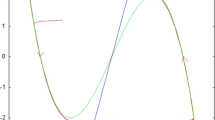Abstract
Spatial pattern formation via Turing instability in the reaction–diffusion system associated with the replicator dynamics is concerned with the long-term effects of perturbations, whereas the notion of reactivity describes the transient behaviour of perturbations to an asymptotically stable equilibrium point. This article establishes the connection between these two concepts—Turing instability and reactivity—in the context of the reaction–diffusion system associated with game replicator dynamics. In particular, we show that for Turing instability to occur in the reaction–diffusion system, the smallest diffusion coefficient of the system must be strictly less than the ratio of positive reactivity of the stable equilibrium point and square of wavenumber. This connection is also explored in terms of elements of the symmetric part of the associated stability matrix.







Similar content being viewed by others
References
Cressman R, Vickers GT (1997) Spatial and density effects in evolutionary game theory. J Theor Biol 184(4):359–369
Gantmakher FR (1998) The theory of matrices, vol 131. American Mathematical Society, Providence
Hofbauer J, Sigmund K et al (1998) Evolutionary games and population dynamics. Cambridge University Press, Cambridge
Johnson CR, Horn RA (1985) Matrix analysis. Cambridge University Press, Cambridge
Murray JD (2007) Mathematical biology: I. An introduction, vol 17. Springer Science & Business Media, New York
Nanda M, Durrett R (2017) Spatial evolutionary games with weak selection. Proc Natl Acad Sci 114(23):6046–6051
Neubert MG, Caswell H (1997) Alternatives to resilience for measuring the responses of ecological systems to perturbations. Ecology 78(3):653–665
Neubert MG, Caswell H, Murray JD (2002) Transient dynamics and pattern formation: reactivity is necessary for turing instabilities. Math Biosci 175(1):1–11
Novozhilov AS, Posvyanskii VP, Bratus AS (2012) On the reaction-diffusion replicator systems: spatial patterns and asymptotic behaviour. Russ J Numer Anal Math Model 26(6):555–564
Park HJ, Gokhale CS (2019) Ecological feedback on diffusion dynamics. R Soc Open Sci 6(2):181273
Qian H, Murray JD (2001) A simple method of parameter space determination for diffusion-driven instability with three species. Appl Math Lett 14(4):405–411
Roca CP, Cuesta JA, Sánchez A (2009) Evolutionary game theory: temporal and spatial effects beyond replicator dynamics. Phys Life Rev 6(4):208–249
Schuster P, Sigmund K (1983) Replicator dynamics. J Theor Biol 100(3):533–538
Smith JM (1974) The theory of games and the evolution of animal conflicts. J Theor Biol 47(1):209–221
Smith JM (1982) Evolution and the theory of games. Cambridge University Press, Cambridge
Smith JM, Price GR (1973) The logic of animal conflict. Nature 246(5427):15–18
Taylor PD, Jonker LB (1978) Evolutionary stable strategies and game dynamics. Math Biosci 40(1–2):145–156
Turing AM (1952) The chemical basis of morphogenesis. Bull Math Biol 52(1):153–197
Vickers GT (1989) Spatial patterns and ESS’s. J Theor Biol 140(1):129–135
Vickers GT, Hutson VCL, Budd CJ (1993) Spatial patterns in population conflicts. J Math Biol 31(4):411–430
Weibull JW (1997) Evolutionary game theory. MIT Press, Cambridge
Author information
Authors and Affiliations
Corresponding author
Additional information
Communicated by Valeria Neves Domingos Cavalcanti.
Publisher's Note
Springer Nature remains neutral with regard to jurisdictional claims in published maps and institutional affiliations.
Rights and permissions
About this article
Cite this article
Kumar, M., Shaiju, A.J. Necessary conditions for Turing instability in the reaction–diffusion systems associated with replicator dynamics. Comp. Appl. Math. 41, 160 (2022). https://doi.org/10.1007/s40314-022-01861-y
Received:
Revised:
Accepted:
Published:
DOI: https://doi.org/10.1007/s40314-022-01861-y
Keywords
- Evolutionary game theory
- ESS
- Replicator dynamics
- Reaction–diffusion systems
- Turing instability
- Reactivity




